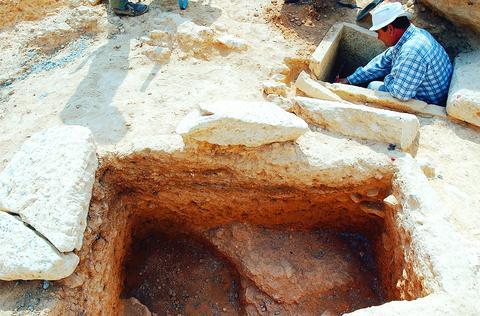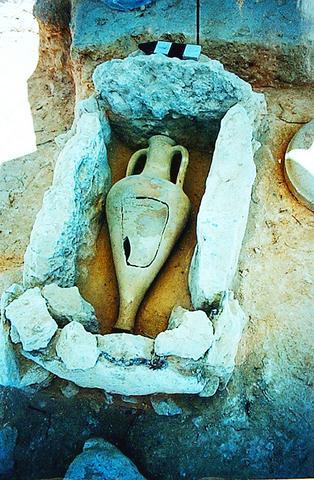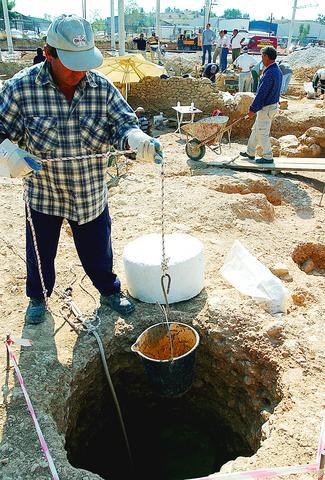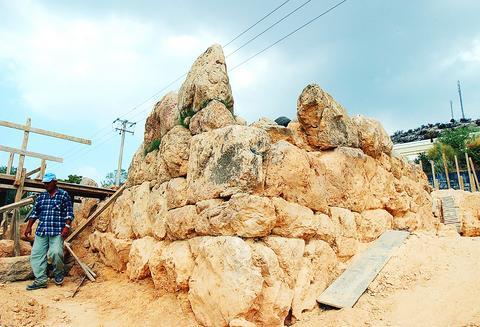A cloud of white dust hovers over Athens' former international airport as crews using heavy equipment build sports facilities for the upcoming Olympics.
A few paces away, another team of workers -- with only brushes and garden tools -- carefully digs into the past.
It's part of an unexpected gift for archeologists: Olympic projects clearing the way for the single biggest antiquities treasure hunt in Athens and surrounding areas.

PHOTO: AP
Dozens of Olympic-related works -- from venues to highways -- has touched off a flurry of archeological excavations trying to beat the bulldozers.
The finds so far range from prehistoric settlements to 2,500-year-old cemeteries to ruins from the Roman period, when Emperor Theodosius abolished the Olympics in 394 after Christianity took root, deeming them pagan.
``I don't believe there was ever such a large-scale archeological excavation in Athens,'' said archeologist Dina Kaza, who heads the excavation at the old seaside airport.

PHOTO: AP
Extra archeologists and specialized researchers have been hired. Crews have worked round-the-clock shifts to keep pace with Olympic construction, which is moving at full speed to compensate for years of delays. The Olympics are scheduled to begin Aug. 13.
Kaza, who oversees excavations in five Olympic-related work sites, says the finds so far have not been headline-making -- like the back-to-back discoveries in 1997 of sites believed to be the lyceum, or school, of Aristotle and an ancient cemetery mentioned as the burial place of the famous statesmen Pericles.
But the quantity of finds adds important details and richness to the understanding of how Athens developed over the centuries, she said.

PHOTO: AP
``We never know what the ground is hiding from us,'' said Kaza. -- at the site of a new tram line storage shed -- found 150 graves as old as 7BC.
Another archeologist, Maria Platonos, uncovered a ceramic vessel depicting a victorious javelin thrower at a cemetery from the Classical period, spanning from 500BC to 323BC, on a road to the Olympic Village north of central Athens.
The athlete is being crowned with ribbons by two messengers from Nike -- the goddess of victory in Greek mythology -- said Platonos, who heads excavations at the Olympic Village and two other Olympic sites.

PHOTO: AP
She said that the artifact, dating to 470BC, had been used at a victory ceremony and was later placed on the grave of the young man awarded the prize.
``Finding this in the area of the Olympic Village was truly something unexpected and very fortunate,'' she said.
At times, though, antiquities were so massive that relocation was not an option.
At the Olympic Village, Platonos' team discovered an extensive system of underground pipelines from the Roman period used to supply Athens with water from nearby Parnitha Mountain. The system was in use until the 19th century.
``This pipe was excavated and cleaned, and now there are plans to make this monument more visible along the zone of greenery at the Olympic Village,'' Platonos added.
At the rowing center in Schinias, about 30km northeast of Athens, researchers found three early Bronze Age dwellings from about 4,000 years ago. Some of the ruins were relocated to allow construction of the Olympic venue.
Potential conflicts between preservation and modernization have required some creative solutions.
Construction of a road to Athens' new airport uncovered another roadway and building foundations that were at least 2,500 years old.
``They indicate an economically vibrant community,'' said Kasimi Soutou who oversees the excavation.
She said the archeological council ruled to preserve the ancient around the old roadway, but the roadway itself will be paved over after any antiquities are removed.
The sports complex on the site of Athens' former international airport -- which also will host baseball, fencing and other sports -- is among the most delayed of Olympic sites.
Archeologists argue that the delays are not their fault.
``We always have this problem. The archeological work always starts at the last minute when it could have started a long time ago, but, unfortunately, the construction plans were not ready on time,'' said Kaza. ``So we are racing until the last minute and they tell us to finish because they have to finish, too.''

We lay transfixed under our blankets as the silhouettes of manta rays temporarily eclipsed the moon above us, and flickers of shadow at our feet revealed smaller fish darting in and out of the shelter of the sunken ship. Unwilling to close our eyes against this magnificent spectacle, we continued to watch, oohing and aahing, until the darkness and the exhaustion of the day’s events finally caught up with us and we fell into a deep slumber. Falling asleep under 1.5 million gallons of seawater in relative comfort was undoubtedly the highlight of the weekend, but the rest of the tour

Youngdoung Tenzin is living history of modern Tibet. The Chinese government on Dec. 22 last year sanctioned him along with 19 other Canadians who were associated with the Canada Tibet Committee and the Uighur Rights Advocacy Project. A former political chair of the Canadian Tibetan Association of Ontario and community outreach manager for the Canada Tibet Committee, he is now a lecturer and researcher in Environmental Chemistry at the University of Toronto. “I was born into a nomadic Tibetan family in Tibet,” he says. “I came to India in 1999, when I was 11. I even met [His Holiness] the 14th the Dalai

Following the rollercoaster ride of 2025, next year is already shaping up to be dramatic. The ongoing constitutional crises and the nine-in-one local elections are already dominating the landscape. The constitutional crises are the ones to lose sleep over. Though much business is still being conducted, crucial items such as next year’s budget, civil servant pensions and the proposed eight-year NT$1.25 trillion (approx US$40 billion) special defense budget are still being contested. There are, however, two glimmers of hope. One is that the legally contested move by five of the eight grand justices on the Constitutional Court’s ad hoc move

Stepping off the busy through-road at Yongan Market Station, lights flashing, horns honking, I turn down a small side street and into the warm embrace of my favorite hole-in-the-wall gem, the Hoi An Banh Mi shop (越南會安麵包), red flags and yellow lanterns waving outside. “Little sister, we were wondering where you’ve been, we haven’t seen you in ages!” the owners call out with a smile. It’s been seven days. The restaurant is run by Huang Jin-chuan (黃錦泉), who is married to a local, and her little sister Eva, who helps out on weekends, having also moved to New Taipei